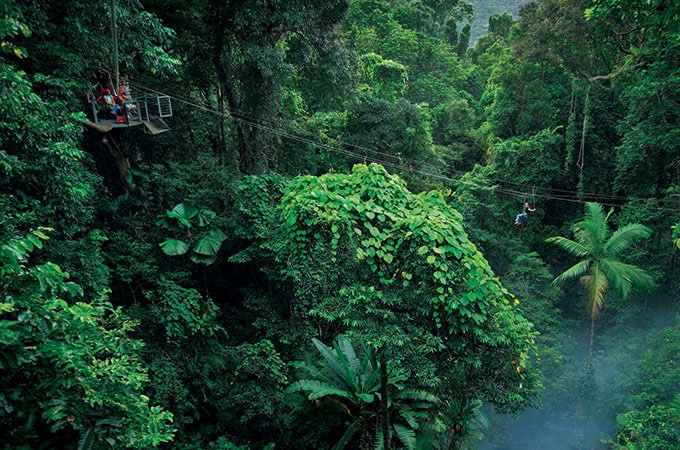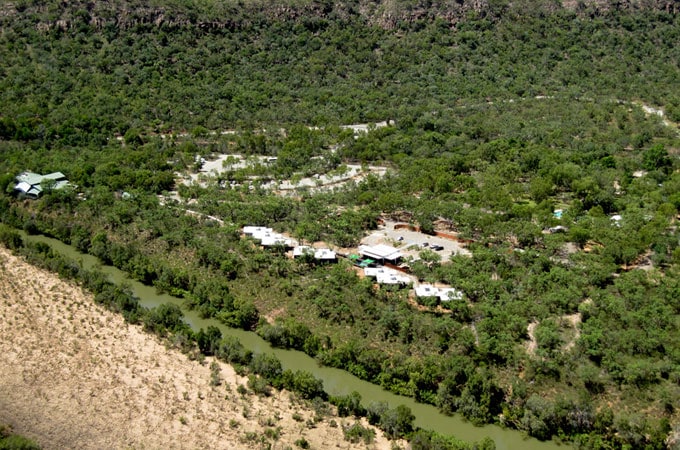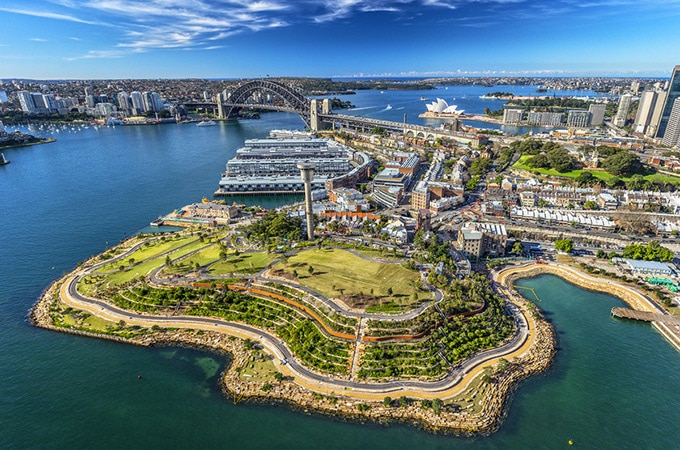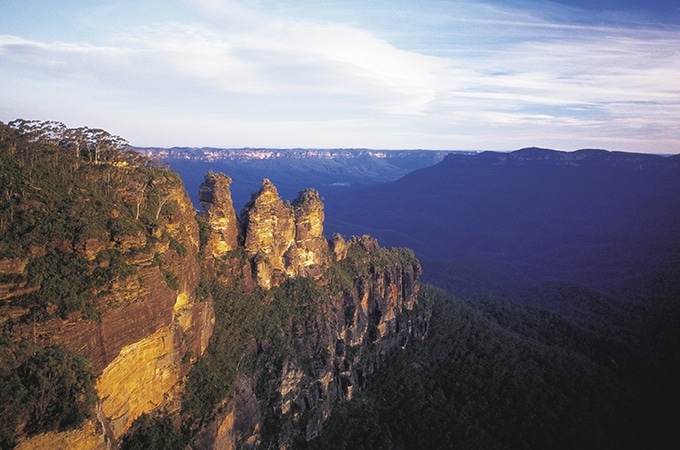From the moment my fiancée, Jenny, and I decided to elope to Tropical North Queensland, we knew our honeymoon was going to be adventurous. We’re not interested in lazing on the beach or sipping cocktails beside the pool. We want to swing, scoot and skid into our first days as man and wife. So with our vows exchanged and our wedding attire folded neatly away, we pull out of Port Douglas and head north to the lush Daintree rainforest to embark on the first of many adventure activities.
Spontaneity is a major component in adventure so I’ve kept the itinerary a secret from Jenny. She’s keen for clues so I tell her that our first activity involves getting mud on her face. Any ideas of visiting a rainforest spa for a facial quickly evaporate as we pull into Daintree Station, a 100-acre stock farm. And as she spies the quad bikes, Jenny realises that her face isn’t the only thing that is about to get muddy.
For the next two hours we’ll traverse furrowed tracks, rocky embankments and narrow rainforest paths. Our first real obstacle is a small dip which leads down into a creek and then steeply up the other side. In my enthusiasm to get to the top I accelerate too hard and ram the bike up a verge. I can see more cloud than ground and the bike feels as though it’s about to topple over. Thankfully, my guide comes to the rescue. And as it turns out I need plenty of saving: I’m towed out of a boggy puddle and then faced the right way again after spinning out on a muddy hill. Jenny has no such dramas.
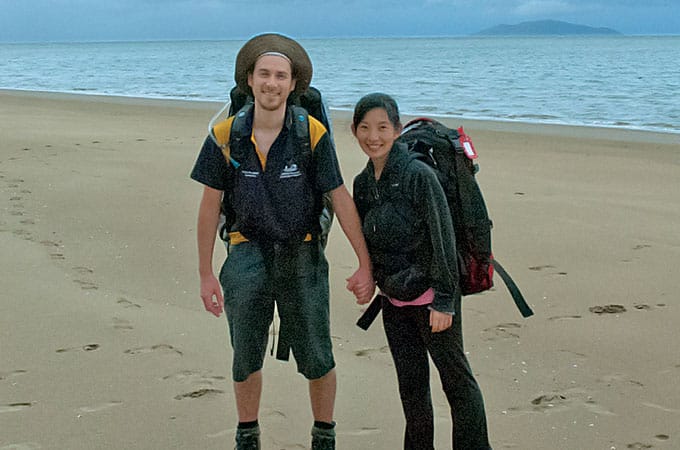
I’m feeling like a quad commando by the time we’re dodging rocks and splashing through a creek. Our journey ends in a large paddock where Jenny rides sensibly and I hoon around. The next thing I know my chassis is jammed in the earth and my back wheels are spinning off the ground. The line between confidence and cockiness is a slim one indeed.
With the mud cleaned off our faces we head further north, to Cape Tribulation, where I become James Bond and Jenny becomes Barbie. At least, these are the names written on our jungle surfing helmets.
We’re standing nearly 20 metres off the ground, above the canopy of the world’s oldest rainforest. Our mission, as a secret agent and beauty icon, is to whizz between a series of five platforms on ziplines.
The longest zipline is 78 metres and halfway down our guide halts the descent and leaves us dangling above a fast flowing creek. Banana plants and other tropical trees fan out their lush leaves, and I spy with my wide open eyes something beginning with GBR. It’s not the nationality of my tuxedo-clad persona, James Bond, rather the Great Barrier Reef which is visible through a break in the trees.
Related article: There’s Nowhere in the World like Tropical North Queensland
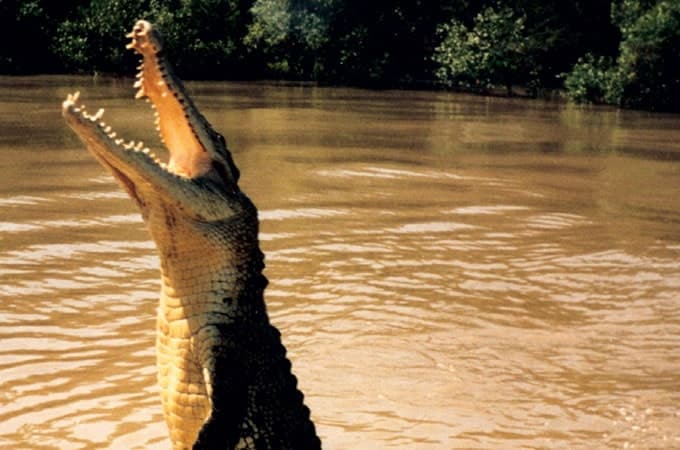
In true 007 style, I turn upside down for my final zip. My fingers brush the canopy and my arms flail as I descend the final 25 metres. I arrive at the platform disorientated, dizzy and desperate to go again. Live and Let Die is one of my favourite Bond movies and there is a scene where Roger Moore is trapped in the middle of crocodile enclosure. He escapes by leaping on the crocodiles’ backs, as if they were stepping stones, and jumping over a fence. While I’m not keen for our honeymoon to get that adventurous, it would be exciting to see a crocodile in the wild.
Lawrence Mason has been guiding tourists around his 170-hectare property since the early 1980s, showing visitors resident crocs living in the mangroves. Lawrence is at a wedding tonight, so we’re left in the capable hands of Coral who is armed with a high-beam torch and leads us along the undulating paths of Lawrence’s rainforest property, past 600-year-old mahogany trees, yabby-filled creeks and a melange of twisted tree roots.
Dragonflies hang asleep from branches. An eastern water dragon looks at us quizzically as we pass, and a grandmother moth vibrates – a defence mechanism to scramble the sonar waves of predatory bats. Gigantic fan palms shelter us from the rain and we find a small bird hunched underneath one.
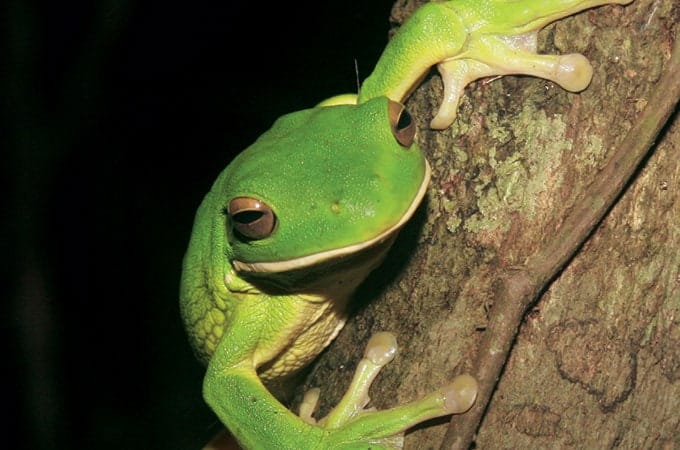
Coral then tells us to switch off our torches. We stand motionless for several moments, captivated as parts of the jungle turn luminous. Coral hands me a stick that is seemingly glowing from the inside. The luminosity is caused by fungi. They glow to attract insects who then walk along the stick and spread the fungi’s spores around the forest.
Rain buckets as we emerge from the rainforest and enter the crocodiles’ mangrove lair. It’s high tide and rain pinpricks the water. Coral tells us to stand well back from the water’s edge; crocodiles are capable of jumping six metres from the murky depths. We follow Coral’s torch beam across the water, on constant alert for the appearance of a crocodile’s beacon- like eyes. But as rain pounds the canopy and the mangroves remain motionless, it’s clear that tonight will be a croc-less night.
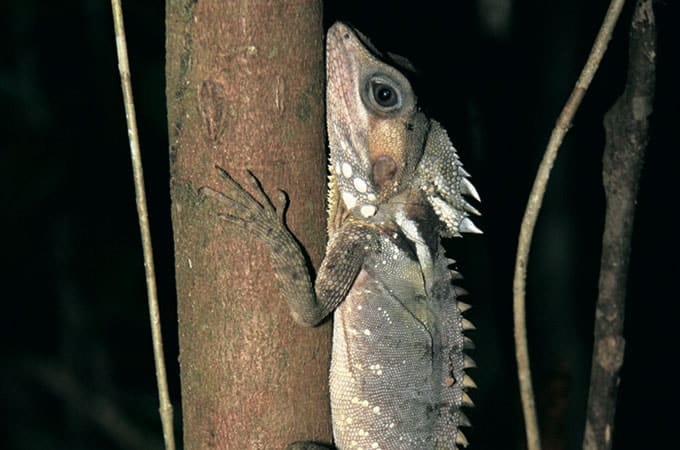
Around 45 minutes south of Cairns is a place where it’s safer to get into the water. Jenny and I have driven to a fast and frothy section of the Mulgrave River to try river tubing. Plucky tubers park their derrieres in big, inflatable tyres and whirl, shout and splash their way down the rapids, all the while flanked by kayak-paddling guides. Where you look is generally where you end up. I’m unable to take my eyes off a large rock up ahead. I spin out of control as I smack into it and enter the rapids backwards. The buoyancy of the tube saves me from bruising, but I’m propelled towards some low-lying branches and avoid them by the narrowest of margins. Jenny’s rapid ride is smoother but only because she’s clinging onto branches every few metres to kill her speed. Eventually we complete the one-kilometre course and clamber onto the bank, soaking yet unscathed and with our adrenaline pumping as quickly as the river.
Time to calm things down. Well, slightly.
Thinking of a romantic getaway to tropical North Queensland? Find your dream Queensland accommodation here.
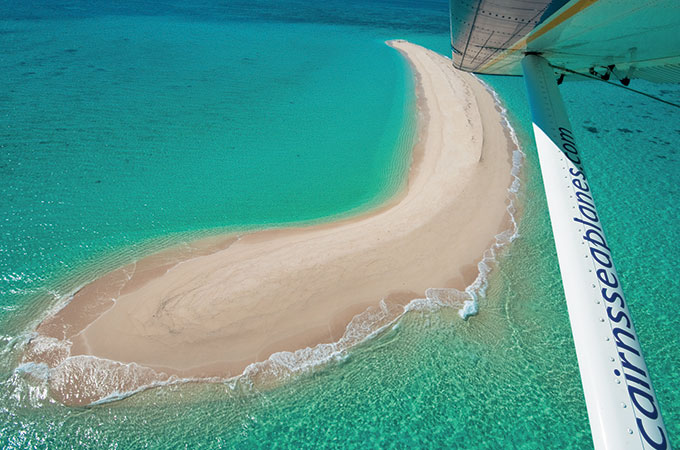
Jenny’s expression is hard to gauge as we approach Cairns Seaplanes. In our five years together today is the day I discover that she suffers from mild vertigo. This explains her rather rigid posture during our jungle surfing jaunt. Nonetheless she’s willing to give it a go, especially when I tell her that the plane will be flying us over Fitzroy Island, a small landmass 29 kilometres southeast of Cairns, where we will later enjoy a relaxing night in a resort.
Rain cloaks the hills a fuzzy grey as we take off. Jenny soon forgets about her vertigo, distracted by the blue, green and turquoise shades of the Great Barrier Reef. We fly over isolated sand cays, one of which is shaped like a whale. The pilot’s voice crackles into our headphones. “Compliments of Cairns Seaplanes,” he says, pointing ahead. A rainbow has appeared, as if by magic, and arcs vividly against the dull, grey sky.
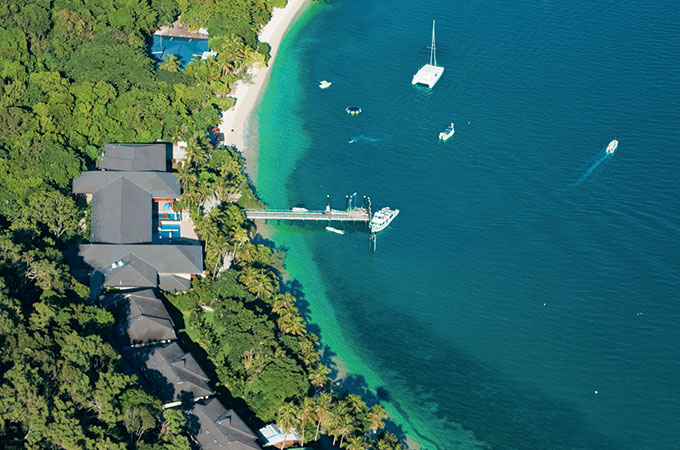
Fitzroy Island
Less than an hour boat ride later we are on Fitzroy Island and I haven’t just brought Jenny here to wine and dine her in a restaurant with a gorgeous sea view. On Fitzroy Island you can do something that you can’t do anywhere else in Australia: hire out the world’s fastest snorkel scooter. These zippy machines have a top speed of 20km/hour and can dive to a depth of 40 metres.They were developed by the German military and used on stealth submarine missions by frogmen who attached mines to the bases of enemy ships. Andre Kiefer, a young German entrepreneur, has shipped a handful of these scooters over from Germany and hires them out to tourists. He also plans to sell them to coastguards, sea customs patrol officers and fishermen.
To drive a snorkel scooter you have to keep your arms straight, unless you want to dive. I’m more than happy to stay on the surface and tightly clasp two joystick-like grips. There is a trigger on one that I squeeze to accelerate; one joystick has a green button on top which moves the engine up through seven gears.The other one has a red button which decreases the gears.
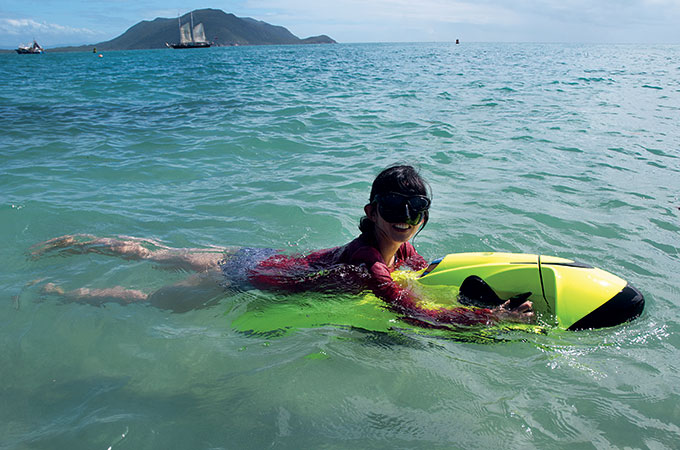
I leave Jenny to scoot through a school of black fish and head away from the shore, against the current, in the dizzy heights of third gear. I’m just about to let out a “woo-hoo” when a wave of water hits me and I swallow a mouthful of sea water. This spooks me a little so I turn around and power back to shore, frantically tapping the green button until I reach top gear. I’m riding on the crest of a wave and it feels like the snorkel scooter is about to fly out of my hands. If it does then the engine will automatically cut out and I won’t be left stranded in the middle of the ocean, a thought that terrifies me.
After the excitement of the scooters, it’s time to say a fond farewell to Fitzroy Island and head out to our next adventure: a day-long snorkelling and scuba diving trip on the Great Barrier Reef with Ocean Freedom. I’ve put my name down for a scuba dive with great trepidation. I nearly drowned when I was ten and the thought of sinking 20 metres beneath the surface (the depth to which we’re diving today) is making my knees knock.
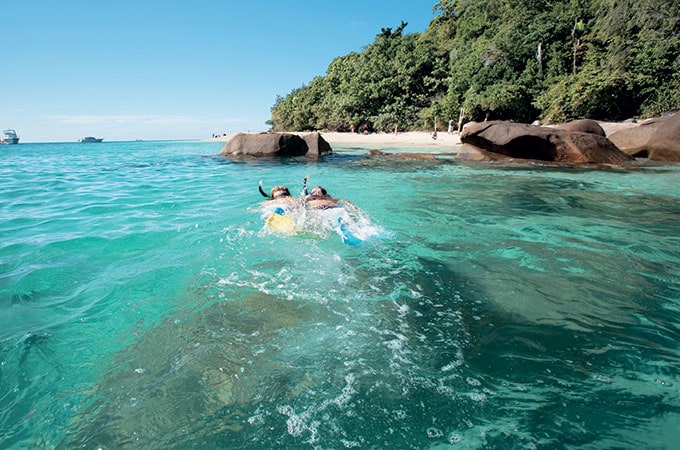
The day is overcast and the sea is a little choppy. The boat has anchored in the middle of the reef and one of theOcean Freedomcrew takes Jenny and me out snorkelling. Neither of us are competent swimmers so we cling onto a rubber ring while the crew member drags us around. Fear surges each time I dunk my head underwater. Breathing suddenly becomes difficult and my body feels helpless.
Back on board I tell a crew member that I don’t want to scuba dive anymore, citing blocked nasal passages as the reason. He sees straight through my wafer-thin excuse and gently encourages me to give it a go, reassuring me that if I get into trouble I can always come straight back up.
Ten nervous minutes pass as I’m suited up and briefed on safety. My scuba instructor, Matt, leads me to the edge of the boat and tells me to jump into the ocean. I freeze. The water may as well be a pit of fire. I think of Jenny and her courage on the seaplane and from her bravery I draw strength, inhale deeply and take the plunge.
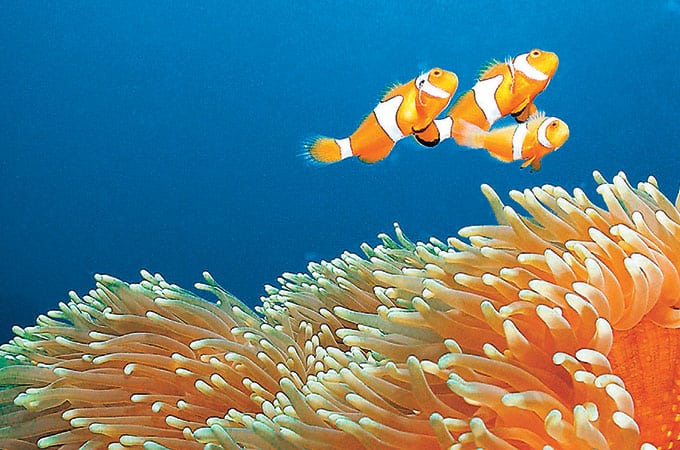
Bubbles overwhelm me. For a moment I almost panic but Matt is soon by my side, holding my hand and inflating my lifejacket. I bob on the surface and dip my head underwater to practice breathing through the regulator; the air is as crisp as a Tasmanian winter morning. Matt deflates my lifejacket and I slowly sink into a blue abyss of childhood memories, of being dragged out of a swimming pool kicking, hyperventilating; snot and tears pouring down my face. I sink beneath the trauma; everything is calm away from the waves. The reef is awash with colour, with coral that looks like brains, red autumnal trees and purple broccoli. Matt leads me through an underwater fairyland. Different childhood memories are resurfacing now, ones of faraway lands filled with curious plants and colourful creatures. Suddenly my fear seems as distant as the ocean floor. How indebted I am to the fantastic crew aboard Ocean Freedom for encouraging me to give it a go.
Hinchinbrook Island
For our final adventure, Jenny and I head south of Cairns for a four-day hike on Hinchinbrook Island. Our packs may be heavy but spirits are light as we trek along deserted beaches, through tracts of swamp and boulder hop along the Thorsborne Trail, a 32-kilometre wilderness wander. Not washing properly for four days may sound like a killer for romance, but our immersion in the wilderness is stripping life down to its essential elements; it’s enhancing our appreciation for the simple things.
Being handed a bowl of condensed milk and muesli in my sleeping bag is suddenly transformed into the best breakfast in bed ever – especially when the view through the tent flaps is of the sun rising over a glistening ocean. Eating lunch beside gushing waterfalls spreads a slice of paradise into our sandwiches, and sunset strolls along secluded coves are ideal ends to any day.
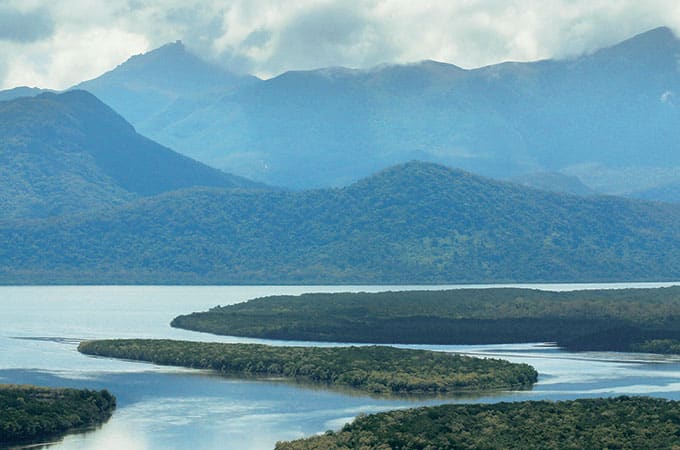
Palm Cove
No adventure honeymoon would be complete without a little pampering for tired muscles. And so, for our last night, I whisk Jenny away to Australia’s most award-winning spa at the Reef House Resort in Palm Cove. Our bodies melt under the touch of our masseuses’ hypnotic fingers. They soothe our aches using long, wispy motions inspired by ancient Aboriginal techniques.
After the massage we head to the Reef House Restaurant. Just twenty-four hours ago we were eating watery miso soup with noodles and carrots. Now a blue cheese soufflé is making my eyes roll into the back of my head, and I have the prospect of a Cointreau orange crème brûlée to savour for dessert – an immeasurable improvement on crushed biscuits covered in Hinchinbrook Island sand!
This adventure honeymoon has set a benchmark for how Jenny and I intend to approach married life. Marriage is an adventure and our escapades over the last fortnight have not only strengthened our trust in one another, but they’ve also encouraged us to surrender our fears. En route we’ve discovered new things about each other and ourselves, and although the honeymoon may be over what we’ve learnt from it will propel us forward, arm in arm, towards ever-new horizons.
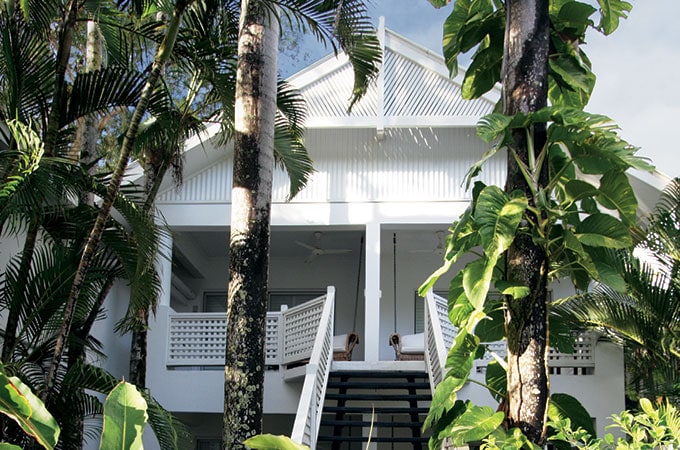
GETTING THERE: In Australia,Virgin, Jetstar and Qantas all fly to Cairns from various destinations.
CLIMATE: Far north Queensland has a wet tropic climate which means there are only two seasons: wet and dry. In the dry season, temperatures range from 24°C-33°C; in the wet season it is 14°C-26°C. Monsoonal rains dump the majority of the region’s annual rainfall between November and May. On average, there are over 300 days of sunshine a year.
HEALTH: While it’s warm enough to swim year round, from October to May box jellyfish inhabit many coastal areas. Also watch out for crocodiles – especially between September and April when it’s their breeding season.
